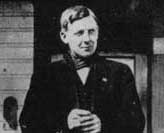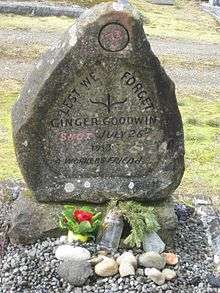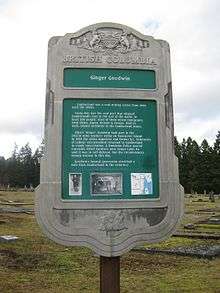Albert Goodwin
Albert "Ginger" Goodwin (May 10, 1887 – July 27, 1918) affectionately named for his bright red hair, was a migrant coal miner who advocated for workers rights and promoted the proliferation of trade unions in British Columbia, Canada.[1] Disgruntled by working conditions within coal mines, Goodwin sought to increase wages, improve working conditions, and fought against companies that disregarded their workers' rights.[2] Goodwin participated and led multiple strikes, and served as a delegate for the British Columbia Federation of Labour, and as an organizer for the Socialist Party of Canada.[3] In the years following his increased activism and involvement with labour unions, Goodwin fell under scrutiny for his beliefs against military conscription and was killed in the year of 1918.[3] There is contention on whether Goodwin was a victim of murder or if his death was the result of self defence.[1] His death inspired a one day general strike in Vancouver on August 2, 1918, which was the first general strike ever held in Canada.[3] This strike served as the precursor to the Winnipeg general strike of 1919, and multiple other labour conflicts.
Albert "Ginger" Goodwin | |
|---|---|
 | |
| Born | Albert Goodwin May 10, 1887 Treeton, Yorkshire, England |
| Died | July 27, 1918 (aged 31) "Mount Ginger Goodwin" west of Cumberland, British Columbia, Canada |
| Cause of death | Single gunshot/head trauma |
| Resting place | Cumberland cemetery 49.637485°N 125.006775°W |
| Monuments | Memorial headstone |
| Nationality | English |
| Other names | Ginger Goodwin |
| Citizenship | Canadian dual national |
| Occupation | Coal miner, labour unionist |
| Years active | 16 |
| Known for | Advocating organized labour, dying a controversial death, martyrdom |
| Home town | Treeton, Yorkshire, England |
| Political party | Socialist Party of Canada (SPC) |
| Movement | Organized labour movement |
| Criminal charge(s) | Evading conscription into the Canadian Army |
| Criminal penalty | State ordered apprehension |
| Criminal status | Killed during apprehension |
Early life and radicalization
Goodwin was born in Treeton, Yorkshire, England on May 10, 1887.[1] In 1906 at the age of 19, he immigrated to Canada and spent time working as a coal miner in Glace Bay, Nova Scotia.[3] In 1911, he relocated to Vancouver Island, where he worked for the Canadian Collieries mining company in Cumberland, British Columbia.[3]
While Goodwin lived in Cumberland his participation in labour activism began, he joined the Socialist Party of Canada and become an active member of the Cumberland Local 2299 union.[1] During the 1912–1914 Coal Miner's Strike against Canadian Collieries, Goodwin became a key activist, speaking out against working conditions, advocating for mine safety and union recognition.[3][2] While the strike did not garner favourable change for workers, it had major political and economic impacts on the country leading to recognition for the strikers grievances.[1] Following the end of this strike in 1914, Goodwin emerged as a dedicated socialist and began his work as a union activist. As a result of his involvement in the strike, Goodwin found himself blacklisted from mining and was forced to move away from Cumberland to find work.[3]
In 1916, Goodwin moved to the East Kootenay region of British Columbia, settling in Trail, British Columbia.[1][2] This is where Goodwin's involvement in politics and union activism increased.
Labour activism
In 1916, Goodwin moved to Trail, British Columbia, where he worked as a "smelter man" for the Consolidated Mining and Smelting Company of Canada Limited.[1] The same year he joined the Mining and Smelter workers Union where he was elected as Secretary for the Trail chapter.[4] Following his involvement with trade unions, Goodwin entered politics running as a candidate for the Socialist Party of Canada in the 1916 British Columbian election representing Trail.[1] Although he did not win, Goodwin carried on with his union activity. The following year he was elected to the executive of the British Columbia Federation of Labour as Vice-President, and as the President of District 6 (Kootenays) of the International Union of Mine, Mill and Smelter Workers.[2][4]
Goodwin commonly spoke out against Canada's involvement in World War I as a conscientious objector.[3] He rejected conscription on the grounds that workers of one country should not be employed to kill workers of another country under the influence of a capitalist conflict.[1] Goodwin is credited with saying, "War is simply part of the process of Capitalism. Big financial interests are playing the game. They'll reap the victory, no matter how the war ends."[5]
While Goodwin eventually did sign up for the draft, he was initially exempted from conscription after a medical examination found him unfit for service.[3] Following his exemption, Goodwin called for a strike on November 10, 1917 at the Trail Smelter where he worked in an attempt to establish an eight-hour work day.[1] As the strike continued, Goodwin was recalled for medical examination and as a result, was then ordered to report for duty for overseas, contrary to the decision priorly made.[1][3][2]
Death
After being reinstated for conscription, Goodwin attempted to appeal his assignment for conscription but was denied multiple times.[2] After being denied, he returned to Cumberland once more to prepare his final appeal.[1] While back on Vancouver Island, Goodwin and other draft evaders fled to the hills of Cumberland in sometime in April or May 1918, hiding out in the mountains around Comox Lake.[1] By breaking into a cabin, Goodwin and the other objectors were able to survive with supplies provided by friends and community members.[1]

On July 27, 1918 Dominion Police ventured into the hills surrounding Comox Lake to locate men evading the draft and arrest them for their evasion.[3] On this day, a Dominion Police Officer by the name of Dan Campbell encountered Goodwin in the woods surrounding Comox Lake.[1][4] Upon his encounter with the activist, Campbell shot Goodwin with a .30-30-calibre lever-action hunting rifle.[1] Campbell claimed that the shot was fired in self-defence after Goodwin raised his own rifle at him after asking him to surrender.[3]
It is unknown how the two men actually encountered each other, as there were no other witnesses to the event.[6] There is debate whether Campbell actually fired in self-defence or if he shot Goodwin deliberately, acting under special military orders.[1][3] Goodwin died immediately after being shot in the neck, with the bullet severing his spinal cord on impact.[3]
Local undertakers refused a police request to bury Goodwin on the spot where he was shot, and also refused to retrieve his body for authorities.[2] His body was retrieved by friends and brought into Cumberland, where it was taken through the streets in a mile long procession.[2] Goodwin was interred at the Cumberland Municipal Cemetery, where thousands attended his funeral on August 2, 1918.[6][3]
Campbell was charged with manslaughter following Goodwin's death.[3] A grand jury in Victoria, British Columbia dismissed the charges of manslaughter against Campbell, who claimed he fired in self-defence. Despite the jury's decision, police officers and two justices of the peace felt there was enough evidence to warrant a further proceeding.[6][2]
There are conflicting opinions on the actual date of Goodwin's death. While many sources date his death occurred on July 27, others including his headstone state he died July 26.
Legacy
Following Goodwin's death, the British Columbian labour movement was outraged.[3] In protest to his murder, the Vancouver General Strike took place on August 2, 1918, which was the first of its kind in Canada.[1] The Metal and Trades Council was the first to call for the 24-hour work stoppage, with the Vancouver Trades and Labour Council, and other manual labourers following their lead.[4]
Around Comox Lake Goodwin is commemorated by the naming of Ginger Goodwin Creek in 1982, and Mount Ginger Goodwin in 1989.[7] A section of the Vancouver Island Highway 19 that passes through Cumberland was named "Ginger Goodwin Way" in 1996, in honour of the activist.[8] Although the signs were removed by the British Columbian Liberal government in 2001, the NDP government reinstalled the signs in June 2018, in commemoration.[9]
On July 27, 2018, the British Columbian government proclaimed "Ginger Goodwin Day," to acknowledge the progress Goodwin achieved to improving work conditions.[9] This day marked the centennial of the reformers death, leading to a widespread acknowledgment of his actions.[7]

Goodwin's legacy was revived in Cumberland with the start of Miners' Memorial Day in 1986.[10] Organized by the Cumberland Museum and Archives, this annual event celebrates the memory of Cumberland's Miners, including the 295 who have died in various mining accidents over the decades.[10] A graveside vigil is held every year during Miner's Memorial weekend, where individuals can place flowers honouring Goodwin.[11]
In 2015 the film "Goodwin's Way" was filmed. The film documents the town of Cumberland, BC, resisting the opening of a new mine and resurrecting the legacy of Ginger Goodwin. Residents share their varied viewpoints on the story of the rebellious labour hero.[12]
Quotes
"...we know that all this misery is the outcome of someone's carelessness and that someone is the capitalists, those who own the machinery of production... This class of parasites have been living on the blood of the working class, they are responsible for the conditions existing at the present time... To throw this system over we have got to organize as a class and fight them as class against class... and our weapons are education, organization and agitation... and the principles of Socialism, for it is necessary that you know when to strike and how to strike, and if we have not these weapons when the time comes, we shall not be able to predict the outcome of the fight... we have the power and the lever to overthrow the existing society."[13]
References
- Stonebanks, Roger. (2004). Fighting for dignity : the Ginger Goodwin story. St. John's, NL: Canadian Committee on Labour History. ISBN 1894000064. OCLC 53305977.
- Parker, Keith (Spring 1997). "Ginger Goodwin: Union Organizer". B.C. Historical News. 30: 24. ProQuest 205051879.
- Leier, Mark (1997). "Plots, Shots, and Liberal Thoughts: Conspiracy Theory and the Death of Ginger Goodwin". Labour / Le Travail. 39: 215–224. doi:10.2307/25144113. ISSN 0700-3862. JSTOR 25144113.
- National Archives of Canada. Library and Archives Canada. (2001). The Canadian West. Library and Archives Canada. OCLC 81089550.
- "Working People: A History of Labour in British Columbia". Knowledge. Retrieved March 13, 2017.
- Hawthorn, Tom (March 17, 2009). "The myth and mystery of Ginger Goodwin". The Globe and Mail. Retrieved March 14, 2017.
- "TWLH-Jul-4". Canadian Labour Congress. October 12, 2017. Retrieved November 22, 2019.
- "Stretch of Highway 19 dedicated as Ginger Goodwin Way". archive.news.gov.bc.ca. June 23, 2018. Retrieved November 22, 2019.
- Labour (July 26, 2018). "Ginger Goodwin Day honours a champion of workers' rights". news.gov.bc.ca. Retrieved November 22, 2019.
- "" About Miners Memorial". Retrieved November 22, 2019.
- "" Ginger Goodwin". Retrieved November 22, 2019.
- "Goodwin's Way". Goodwin's Way. Retrieved March 13, 2017.
- Leier, Mark (July 25, 2014). "To Praise Ginger Goodwin Is to Revere a Radical". The Tyee. Retrieved March 13, 2017.
Further reading
- Mayse, Susan, January 1, 1990, Ginger: The Life and Death of Albert Goodwin, Harbour Publishing, 212 pp., with index and bibliography, ISBN 9781550170184